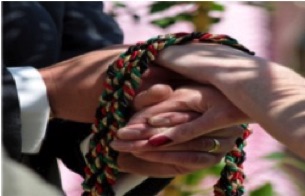Need a Minister Call... St Louis Wedding Chapel Call Us Today at 314 472-5017
Call Today to Schedule your wedding..... 314 472-5017
Located in South St Louis County Between Jefferson Barracks Park & River City Casino - Exit Hwy 270 on Telegraph go north 2.6 miles
Hand fasting Handfasting Ceremony handfasting
Call Us to Officiate your Wedding Ceremony Today...
Wedding Officiant 314 472-5017
St Louis Wedding Chapel
Handfasting Ceremony
Hand Fasting
Hand Blessing

Thinking of making a handfasting part of your wedding ceremony ?

HANDFASTING
What is a Handfasting?
A handfasting is a component of a wedding ceremony which entails gently wrapping cords around the bride and groom’s clasped hands and tying a knot, symbolically binding the couple together in their declaration of unity.
However, the long answer entails a bit of back-story. Today’s modern day handfasting ceremony is a revival – of sorts – of the handfastings of yester yore. The act of handfasting was originally an element to a formal betrothal ceremony (the precursor to today’s engagement) perhaps going as far back as ancient Celtic Scotland, up to the 16th century reformation-era. During the formal betrothal ceremony, in which a couple promises to one another their agreement in future marriage, there was a formal handshake to seal the deal.
The handfasting ritual has been, almost effortlessly, adapted and incorporated into many of our modern wedding rituals as the main ceremonial element in addition to – or instead of – the ring exchange. Modern Pagans revived the literal tying of the knot. But the Truth is that is you go back far enough manyculture celbrated a marriage this way with the tying of the Knot..
Hence, the Expression " tying the Knot "
We all know the phrase, “to take each other’s hand in marriage”, but how often do we stop to think about what this really means? There has been somewhat of a revival in the world of wedding ceremonies to reinstate traditional methods of binding the couple together in matrimony.
During the ceremony, hands are used to exchange vows and rings; however some couples are taking this tradition one step further, using centuries-old practices of tying their hands together in an act called handfasting.
Dating back to medieval times, and originally a Celtic (pagan) custom of betrothal, it became commonly adopted as a legal marriage in the Tudor era, when it did in fact constitute the entire legal wedding ceremony.
Handfasting is a symbol used in Celtic and other cultures to express marriage. It is non-religion-specific, meaning it is not pagan or Christian. It is just human. The symbol can be used by anybody, since it expresses part of the reality of matrimony.
As it is used in the Celtic Catholic Church, during the ceremony, the couple join hands and their hands are loosely tied by a rope. The handfasting lasts only for a few seconds, really, while the couple exchange their vows.
Sometimes a handfasting can use multiple cords representing the bonds of marriage such as, honor, trust, protection, commitment and so on. Hence the saying “ Tying the knot”. There are many types of hand fasting ceremonies some even with its own unique sets of vows which can be added to your ceremony
At the end of it all in another part of the ceremony which be typically added, they turn to leave and are confronted with a broom which has been put in their path. They have to get over it somehow (we leave the details up to them -- they can walk over it together or he can carry her over it.) This is a symbol that what marriage is about is who sweeps the floor, etc. It is not just pretty dresses and romance. Called jumping the broom You will see this particular symbolic action in Celtic and African cultures. It has no pagan connotations, really, Scotland was not the only place to practice handfasting. England also had handfasting.
Note that the marriage law in late medieval England was essentially the same as that in Scotland -- all of Roman Catholic Europe had more or less the same marriage law because marriage came under the jurisdiction of canon rather than civil law.
The fasting cord or sash can be specially made for the tying, and so could include personal elements such as the family tartan or fabrics of particular significance. So it adds a very visual personal element to the ceremony. The binding can be done in all kinds of ways, and knots are often tied with the making of each vow. This leaves the couple with a keepsake cord in which each vow is represented by a knot. The cord can also be used in future anniversaries or vow renewals.
Couples wanting a visual expression of ‘tying the Knot’, but nothing so elaborate as a handfasting might opt for a simple hand tying, which can often be done with coloured ribbons. Depending on how simple or how elaborate you want your ceremony to be, you can, of course, design and write your own ritual, including in it the elements that have special significance for you, and which will best represent your taking of each other’s hands as an important symbol of marriage.
Wedding Chapel Wedding Officiants Elopement Weddings Marriage License Courthouse Wedding Wedding Planning Wedding Venues Justice of the Peace Same Day Wedding Theme Wedding Ceremony Ideas Unity Ceremony Testimonials Bernie Elking Photography Wedding Celebrant Renewal of Vows Wedding Vows Park Weddings Wedding Vendors
